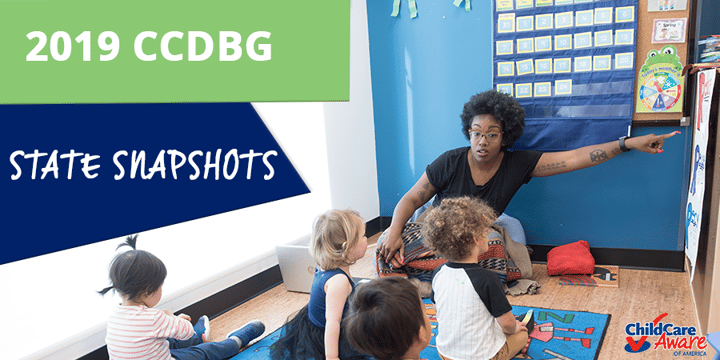Jump to a specific section: |
||||
| What is CCDBG? | Why it Matters | About This Report |
Find Your State | CCDBG Resources |
What is CCDBG?
Established in 1991, the Child Care and Development Block Grant (CCDBG) is the primary federal grant program that provides child care assistance for families in need. CCDBG is administered to states in block grants. States use the program to subsidize child care for working families with low incomes. Most of this assistance is administered through vouchers or certificates, which can be used by parents to select the high-quality provider or program that works best for their family.
Congress reauthorized CCDBG in 2014 with overwhelming bipartisan support. The CCDBG Act of 2014 improved child care health and safety standards, and provided funding to help make quality child care available to more families with low incomes. The 2014 law also mandated that states meet new requirements on comprehensive criminal background checks and disaster preparedness/response planning, among other critical improvements.
Despite the reauthorization, Congress failed to provide sufficient funding to help states make quality child care available to millions of families that need it. Today, states use resources from other federal funding streams, including Temporary Assistance for Needy Families (TANF), to ensure families don’t lose critical access to child care.
Why it Matters
The lack of adequate funding has hampered states’ ability to provide quality child care to working families. Currently, fewer than 1 in 6 families who qualify for child care assistance receive it. Additionally, States continue to request and receive waivers from the Administration for Children and Families (ACF) to delay implementation of the new requirements, particularly background checks. Additionally, FY2017 saw the lowest number of children served by the grant in nearly 20 years.
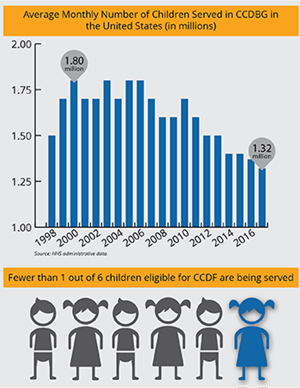
In 2018, Congress reached a budget deal that nearly doubled the amount of discretionary funding for CCDBG, an increase of $2.4 billion. While this funding increase was welcomed, federal funding for child care in FY2018 still remained $1 billion less than FY2001 levels when adjusted for inflation. Given the population growth since 2001, and the health and safety standards added in 2014, it is clear that an even larger investment is needed.
About This Report
While a lack of access to quality child care is a national crisis, each state has a unique child care landscape with highlights and challenges. We worked with partners in all 50 states, who wrote and/or reviewed descriptions on the status of CCDBG funding in the state. All funding estimations are based on state allocation increases in discretionary funding between FY2017 and FY2018, as reported by ACF.
Select a state to learn more about why CCDBG funding matters.
Find Your State
Alabama
CCDBG Update:
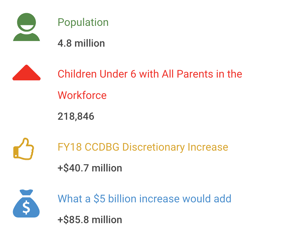 In FY18, Alabama received a historic $40.7 million increase in CCDBG discretionary funding. This new funding enabled the state to increase base payments to child care providers serving families receiving assistance, increase access to training for child care providers, and build upon the state’s quality rating and improvement system.
In FY18, Alabama received a historic $40.7 million increase in CCDBG discretionary funding. This new funding enabled the state to increase base payments to child care providers serving families receiving assistance, increase access to training for child care providers, and build upon the state’s quality rating and improvement system.
The increase in CCDBG funding also enabled the Alabama Department of Human Resources to virtually eliminate the waitlist for child care subsidies. Previously, Alabama parents had to wait three years or more to get help paying for child care. Now, it takes just a few weeks for families to be approved for subsidy.
While this is great news, it highlights the importance of sustaining CCDBG funding to avoid taking away child care from these working families. In addition, more CCDBG funding could help expand access to families just above the qualifying threshold. Currently, Alabama families must be at 130 percent or less of the federal poverty level to qualify. But with the average cost of infant care ranging from $5,000 to $6,000 per year in Alabama, even families well above the threshold struggle to afford quality care. An increase in CCDBG funding could allow Alabama to increase the subsidy eligibility rate, enabling these families to access care as well. Finally, with the passage of the Alabama Child Care Safety Act last year, efforts are still underway to ensure all child care facilities that receive state and federal funds are licensed by August 1, 2019. These efforts will require additional health and safety training for faith-based providers, as well as an expansion of the state’s licensing and monitoring system. More CCDBG funding would help sustain these efforts and ensure more of Alabama’s children are in safe, quality environments.
Thank you to our partners!
Alabama Office of Child Care Subsidy
Alaska
CCDBG Update: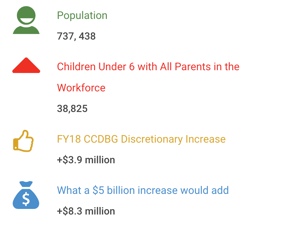
In FY2018, Alaska received a historic $3.9 million increase in CCDBG funding. This funding is vital for expanding access to affordable, high-quality child care for Alaska’s working families. While this increase is important, additional funding is still needed in Alaska to support these families. Child care in Alaska can cost more than college tuition and most families have not planned for those costs. Increased funding could increase qualification standards so that more families could qualify for child care assistance and not penalized for making a higher wage.
For early education programs, Alaska’s Child Care Assistance (CCA) rates are at 13 percent of the market rate for child care subsidies – one of the lowest rates in the nation. This means the vast majority of early education programs accepting children on subsidy must cover most of the cost some other way – often operating at a loss. Raising Child Care Assistance rates enables early education programs to take in more families who are using the subsidy and increases child care options for working families. This is important given the current lack of quality options in Alaska. Workforce support is also needed in Alaska. Currently, the average annual income of early educators in Alaska is $26,530, putting the workforce at or near the federal poverty level if they have children of their own. Combined with limited financial support available for professional development, this results in high turnover in the field and fewer quality child care options for families. CCDBG funds could expand the System for Early Education Development (SEED) in order to increase professional development supports and services to early educators.
Thank you to our partners!
thread Alaska
Arizona
CCDBG Update: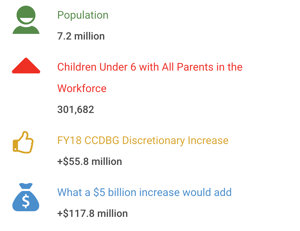
In Arizona, many of the additional requirements of the CCDBG reauthorization have been implemented, including preschool expulsion prevention, 12-month eligibility, maximum group sizes, and health and safety training requirements. Additionally, over the last year, Arizona has implemented various initiatives that have increased the percent of children on subsidy that are placed in quality child care settings from 35 percent to 41 percent. However, improvements to increase quality and affordability of early learning opportunities for children, as well as access for low-income families and children in the child welfare system, continue to remain a critical focus.
Under the leadership of Governor Doug Ducey, the state fiscal year 2020 budget authorized the use of the additional $56 million in federal CCDBG funds to provide across-the-board increases in reimbursement rates (which had not occurred since 2007), provide additional rate increases for quality providers, and suspend the waitlist in the child care subsidy program that had been in place since 2009. It is estimated that this action will raise reimbursement rates by an average of 30 percent and result in approximately 5,000 more children served monthly.
While the additional funding has helped immensely, there is still a gap between the reimbursement rates and the actual rates charged for care. This can inhibit child care providers’ ability to obtain resources necessary to pay adequate compensation to train and retain quality teachers and staff, ensure low child-staff ratios, and cover other costs associated with offering high-quality early care and education to children. This means most providers accepting children on subsidy must cover the remaining cost some other way such as operating at a loss, requiring families to pay more out of pocket, or limit enrollment of families that pay with child care subsidy. With additional Federal CCDBG funds, Arizona could maintain the improvements implemented and continue to increase the reimbursement rates to a level that would better serve both families and providers in Arizona.
Thank you to our partners!
First Things First
Arizona Department of Economic Security and Child & Family Resources, Inc.
Arkansas
CCDBG Update: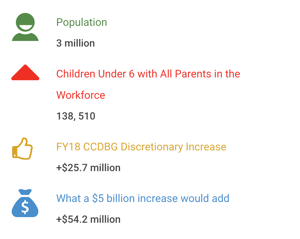
In FY2018, Arkansas received a historic $25.7 million increase in CCDBG funding. The governor announced that this funding will be used for 3,800 new child care assistance slots. This has enabled the state to serve all eligible children on the waitlist as of August 2018.
Despite this huge win, more funding is necessary to increase the supply of child care in Arkansas. Without increasing the supply, families with a subsidy will find it difficult to track down affordable, quality child care for their child. This starts by raising subsidy reimbursement rates, which are crucial to help providers cover the costs of families on the subsidy. More CCDBG funding is necessary to increase the supply of child care and increasing subsidy rates, as well as increasing the capacity of Child Care Resource and Referral (CCR&R) agencies, are two ways to accomplish that.
Finally, Arkansas experiences one of the highest rates of Adverse Childhood Experiences (ACEs) in the country. Currently in Arkansas, 1 in 6 children experience three or more ACEs—much higher than the national average of 1 in 10 (Child Trends, 2018). Additionally, 56 percent of all Arkansas children experience at least one ACE, which is the highest prevalence in the country. Without proper intervention, ACEs can negatively impact a child’s development. In Arkansas, Child Care Aware® agencies are the first points of contact for child care providers who are seeking support when in contact with children who experience ACEs. Expanding CCDBG funding could provide further assistance to better prepare early educators to help children affected by ACEs.
Thank you to our partners!
Child Care Aware of West Central Arkansas
California
CCDBG Update: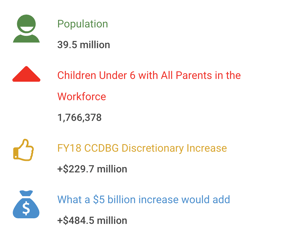
With its historic increase of approximately $230 million, California lawmakers chose to heavily invest in CCDBG compliance in the FY19 budget. This included funding to increase staffing so that licensed providers could undergo annual inspections, as well as funding to develop a statewide consumer education website. Further funding was invested in the Child Care Initiative Project in order to address the 30 percent decline in family child care homes that California has been experiencing since 2008. Prior years' funding allowed California to increase the reimbursement rate for providers and programs serving families with a child care subsidy to the 75th percentile of the most current Regional Market Rate (RMR). Additionally, families have 12 month eligibility and an increased exit level to 85 percent of state median income (SMI).
Current analysis shows that there are 1.8 million children in California whose families qualify for child care assistance and need the service, yet don’t receive it due to lack of funding. However, with last year’s increase, only 13,307 new vouchers were administered, 11,207 of which are set to expire in 2022. Advocates are currently requesting that the state invest in 100,000 child care spaces over the next three years. It is unlikely that California will make any significant headway in serving eligible families without significant and continuous federal funding to combine with state funding. 
Thank you to our partners!
California Child Care Resource & Referral Network
Colorado
CCDBG Update:
Due to limited funds, Colorado is only able to serve 9 percent of the income-eligible populations who qualify for child care assistance. Additional CCDBG funding could assist the state in providing child care to parents who meet eligibility requirements but for whom the current funding level is insufficient. Additional funding could also allow Colorado to address waitlists within the Colorado Child Care Assistance Program (CCCAP).
Subsidy reimbursement rates for providers directly impact access for families with low incomes. In Colorado, child care reimbursement rates range from the 25th to the 75th percentile for infant and toddler care and from the 10th to 75th percentile for all other age groups, according to the 2017-2018 Market Rate Study. Additional CCDBG funding would permit Colorado to further increase provider reimbursement rates to ensure that more underserved children have equal access to care.
Thank you to our partners!
Office of Early Childhood, Colorado Department of Human Services
Connecticut
CCDBG Update: 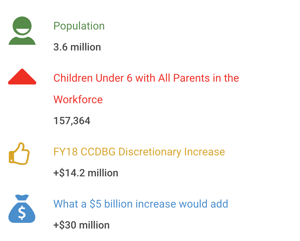
In FY2018, Connecticut received a $14.2 million increase in CCDBG funding. This increase in funding will help low-income families working or participating in education and training programs with paying for child care. The state will also use the funds to fully implement the provisions of the CCDBG reauthorization law.
However, with the average cost of care currently rivaling or greatly exceeding the cost of college tuition in Connecticut, and over 157,000 children under age 6 with all parents in the workforce, more funding could greatly expand access to Connecticut’s subsidy program, Care 4 Kids. Since infant care can be as high as 12.6 percent of income for an average married couple and a staggering 48.7 percent of income for average single parents, most families cannot access child care without this subsidy. Each month, 2-1-1 Child Care, Connecticut’s resource and referral agency for child care services, makes numerous referrals to state and federally funded programs and to the child care subsidy program. Parents are provided information on program eligibility requirements and receive assistance on completing application forms.
Child care is essential to working families and CCDBG funding supports families’ ability to maintain employment and work toward economic stability. Connecticut child care providers are also supported through this funding with a living wage and access to professional development opportunities to build their knowledge and skills. Thus, increasing CCDBG funding will expand child care access and maintain the supply of child care providers in Connecticut.
Thank you to our partners!
United Way of Connecticut
Delaware
CCDBG Update: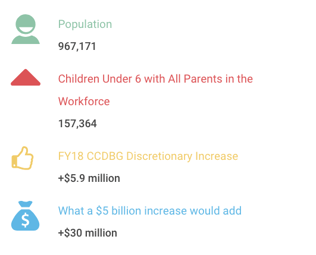
In FY2018, Delaware received a historic $5.8 million increase in CCDBG funding. This funding will be used to implement provisions of the CCDBG reauthorization law such as background checks, graduated phase-out for families using the subsidy, health and safety trainings, and new requirements for license-exempt providers.
Despite this, more CCDBG funding is needed to expand access to children and families so they may benefit from quality early childhood and afterschool care. Currently, Delaware has a child care supply gap of more than 68,000 slots across the state. This means more than half of children under 12 do not have access to a licensed child care provider.
In addition to the supply gap, many Delaware families cannot afford high-quality care. Delaware provides Purchase of Care (POC) subsidies to low-income families who meet the criteria through the Child Care Development Fund. However, the reimbursement rate continues to be below the market rate. Moreover, the average cost of care in Delaware ranges from $7,716 in a home and $10,759 in a center. Many families that do not qualify for subsidy still cannot afford high-quality care, thus locking them out of the system entirely.
More CCDBG funding would help Delaware address these access and affordability issues. For example, Purchase of Care reimbursement rates need to be increased and aligned to the current market rate, which is currently using the 2015 rate, to incentivize more providers to accept families on subsidy. Additionally, more consumer education is needed to spread awareness about the subsidy and help all families find child care that best suits their needs. Finally, more initiatives are needed to increase the supply of quality child care and Pre-K opportunities, particularly in high-need areas.
Thank you to our partners!
Children & Families First
Florida
CCDBG Update: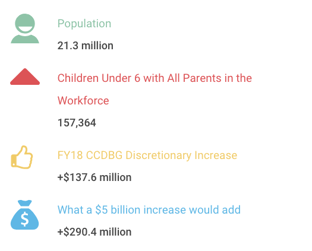
In Florida, over 500,000 children are living below 150 percent of the federal poverty level. In FY2017-2018, less than half of these vulnerable children and families received reimbursements for attending an early care and education (ECE) program and an average of 31,000 children were on the waitlist for this 12-month period. Without additional funding, providers will continue to struggle to meet the needs of this at-risk population.
These families also have difficulty paying for high-quality programs. At the current reimbursement levels, high-quality programs cannot accommodate the financial needs of at-risk families without operating at a loss. For instance, a Volusia County high-quality accredited provider receives an average reimbursement of $174.00 weekly for an infant. To sustain a quality program at the highest level, she must charge $239.00 a week to care for an infant. A single parent with an infant that lives at or below the state’s poverty level ($16,910/year) will be charged the difference of $65 weekly. It is highly unlikely that this parent can pay 20 percent of her income to have her child in a high-quality ECE program.
High-quality programs maintain rigorous health, safety, and education standards for young children, who all deserve equal access to quality care regardless of their parents' socioeconomic status. Thus, Florida desperately needs more CCDBG funding in order to achieve this.
Thank you to our partners!
National Early Childhood Program Accreditation (NECPA)
Georgia
CCDBG Update: 
In FY2018, Georgia received a historic $91.5 million increase in CCDBG funding. With these additional funds, Georgia increased its tiered reimbursement rates for all providers in Quality Rated, the state’s quality rating and improvement system (QRIS). The state also began paying 50 percent above the base rate to providers awarded Quality Rated Subsidy Grants. The state plans to expand the number of Quality Rated Subsidy Grant slots by 500.
Georgia also made a commitment to ensure that no family pays more than seven percent of its income for family fees for child care, as recommended in the federal CCDBG regulations. This commitment to help families will require even more CCDBG funding to cover costs. With more than 500,000 children under age five in households where all parents are in the workforce, the FY2018 increase in CCDBG funding equals just $183 per child potentially in need of care. With the average cost of infant care at $8,327 in a center and $6,454 in a home, more CCDBG funding is needed for Georgia to fulfill its commitment to families.
The state also plans to increase its base payment rates for care for infant and toddler care to the 25th percentile of the 2016 market rates. Raising payment rates is crucial since it helps providers cover the costs for children receiving subsidized child care and expands access to quality programs. However, the new rate remains far below the recommended rate of the 75th percentile of current market rates. If payment rates stay low, providers must cover the remaining costs some other way, often operating at a loss. An increase in CCDBG funding will be necessary to raise these rates and incentivize providers to serve families eligible for subsidized care. 
Thank you to our partners!
Quality Care for Children
Hawaii
CCDBG Update: 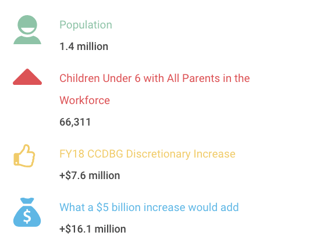
In FY2018, Hawaii received a historic increase of over $7.6 million in CCDBG funding. With over 66,000 children under the age of 6 having both parents in the workforce, these funds have been important for improving Hawaii’s child care system. However, nearly half of these parents still lack access to licensed child care, meaning more can be done in Hawaii to improve equitable access to quality programming.
In Hawaii, child care remains expensive, with the average annual cost of family child care over $7,500 per year and the average annual cost of center-base care well over $10,000 per year, rivaling tuition at a four-year college. On average, single parents pay 45 percent of their income for infant care, while married parents with 2 children at the poverty line must pay 79 percent of their income for center-based care. Without access to the subsidy, many of these families would not be able to afford child care at all.
In addition to the high cost, child care remains difficult to find, with a child care deficit of more than 30,000 slots. Approximately 77 percent of clients looking for care cannot find any. In particular, there remains a severe lack of infant and toddler care in Hawaii. Of the available child care slots, just 11 percent are for infants and toddlers. And currently, there are zero infant programs on the islands of Kauai, Lanai, and Molokai. As a result, many working Hawaiian parents focus on Ohana care, relying on extended families to watch their Keiki so they can continue to work to support a multiple-family unit because the cost of care is too much. CCDBG funds not only help build the supply of child care, but they are crucial to enabling access for many Hawaiian families.
Thank you to our partners!
Patch Hawaii
Idaho
CCDBG Update: 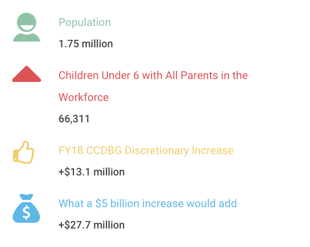
In FY2018, Idaho received an additional $13 million in discretionary funding. These funds will allow Idaho to fully implement the subsidy requirements around graduated phase-out and co-pay adjustments, implement the updated rates for provider reimbursements, and meet the increased inspection and criminal background check requirements for child care providers. Funds will also be used to invest in increased professional development and scholarships.
Reimbursement rates are essential for providers to accept children on subsidy without operating at a loss. Idaho currently provides reimbursement rates at the 65th percentile of the market, according to the 2018 Market Rate study. With additional CCDBG funds, Idaho’s market rate could be improved to the national standard of the 75th percentile. Idaho also has a need to improve wage compensation and the education levels of early childhood educators. According to a 2015 Idaho Workforce Study, 51 percent of respondents have education beyond high school. However, more than half (55 percent) of respondents earn less than $20K a year. With additional CCDBG funding, Idaho could support its early childhood educators through offering increased opportunities for education.
Idaho remains one of a handful of states that does not invest in preschool programs, which leaves a gap in our early childhood education system. Efforts are currently in place to develop a state-funded preschool system, but one of the challenges is a lack of a qualified early childhood educators. With additional CCDBG funding Idaho can boost its efforts to strengthen the ECE labor force, which will position the state to build a preschool system with a skilled and trained workforce in place.
Thank you to our partners!
Idaho AEYC
Illinois
CCDBG Update: 
In Illinois, compensation for the early care and education workforce is at a crisis point. The median hourly wage for teachers in licensed centers is $12.50. While degree attainment leads to higher wages, those teachers with bachelor’s degrees still only earn an average of $13.64 per hour. Low wages mean high staff turnover, which prevents continuity of care and lowers quality. Low wages also make it increasingly difficult for programs to recruit and retain well-qualified teachers. Increased CCDBG funding would allow the state to increase provider reimbursement rates so as to raise teacher pay.
Illinois made great progress in its Quality Rating and Improvement Systems (QRIS) among early care and education providers through Race to the Top Early Learning Challenge funds, with 45 percent of licensed providers achieving levels of quality beyond licensing. However, the number of providers meeting higher levels of quality has stagnated since the depletion of those funds. More CCDBG funding would allow the state to renew supports that help programs get better and thereby increase the number of children experiencing high quality early learning.
Many areas in Illinois lack infant and toddler care. In these “child care deserts,” working parents have to piece together informal and often unreliable care arrangements. As lack of dependable child care is a leading cause of workplace absenteeism. This issue has a real economic impact. Increased CCDBG funding would allow the state to raise subsidy reimbursement rates to more accurately reflect the cost of care.
Thank you to our partners!
Illinois Network of Child Care Resources and Referral Agencies
Indiana
CCDBG Update: 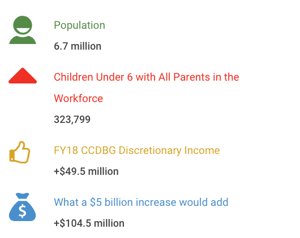
In Indiana, 18 percent of children live in families with low incomes. Additionally, two out of three children live in households with all available parents in the workforce, making access to high-quality care essential for working Hoosier families. The historic increase in CCDBG in FY2018 has allowed Indiana to provide child care for additional children and to focus more on providing high-quality child care for children in foster care. Additional funding will help build on these successes and ensure more Hoosier families have access to high-quality early childhood programs.
Unlike many states, Indiana’s regulatory system already included many of the requirements created by the 2014 reauthorization. As the expectations grew, Indiana was relatively well-positioned to achieve the federal guidelines. However, those quality-focused rules have an historic cost associated with them. CCDBG funds remain inadequate to support the number of working families and their children who meet the qualifications for vouchers.
In addition to expanding access to quality early learning through vouchers, expanded funding gives Indiana the opportunity to bolster the system of quality child care by targeting the competencies of the early childhood workforce. Early childhood programs will be empowered to support families and the early development needs of children. Increasing program quality is essential to keeping pace with the needs of children and families.
Thank you to our partners!
Early Learning Indiana
Iowa
CCDBG Update: 
In FY2018, Iowa received a historic $19.3 million increase in CCDBG funding. This enabled Iowa to raise subsidy reimbursement levels for high-quality providers, which is crucial for helping providers to cover the costs for families receiving the subsidy. Iowa will also remove administrative barriers for families, such as giving families a 12-month eligibility period before having to reapply.
Despite these improvements, there remains a child care crisis in Iowa. Currently, 75 percent of children in Iowa have all available parents in the workforce. Among them, 94 percent are women who involuntarily work part-time due to child care problems. Only 12 percent of children aged 0-5 in families with low incomes have access to quality care. And Iowa has lost 40 percent of its registered child care providers in the last 5 years.
More CCDBG funding is crucial for expanding access to quality child care. The average cost of full-time, center-based infant care in Iowa is $10,131 a year for one child—higher than in-state public college tuition. For a single-parent family at the median income in Iowa, infant child care costs 40.3 percent of earnings. For many families, access to the subsidy is necessary to afford child care so they can work and provide for their children. Almost one-fourth of Iowans live in areas with an undersupply of licensed or registered providers. That number is even worse for infant and toddler care. Poor provider pay is the primary culprit. In fact, early childhood educators are compensated so low that 53 percent receive public benefits themselves. Increasing CCDBG funding could address this wage crisis and help to recruit and retain qualified educators.
Child wellbeing remains an important issue to Iowans, with a recent poll of over 500 Iowa voters finding that 80 percent believe “improving the health, education, and wellbeing of children” is a high priority that presidential candidates need to address. In addition, 58 percent of those surveyed believe that the president and Congress need to invest more money when it comes to children’s wellbeing.
Thank you to our partners!
Iowa AEYC
Kansas
CCDBG Update: 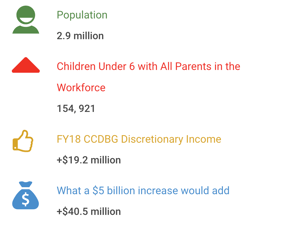
In FY2018, Kansas received a historic $19.2 million increase in CCDBG funding. With this funding, Kansas raised the subsidy reimbursement rate from the 40th percentile of 2014 markets to the 65th percentile of 2017 markets. Subsidy reimbursement is important for helping providers cover the costs for children using the subsidy. By increasing rates, families saw a decrease in their out-of-pocket expenses for child care, thus expanding access to quality child care programs. This is important since Kansas experienced a 16 percent decline in the monthly number of families served by the subsidy between 2015 and 2017, despite no change in the number of families eligible.
Unfortunately, recruiting and retaining child care providers remains difficult without further increasing CCDBG funding. One cause is low wages for child care workers, who, on average, earn less than $20,000 per year in Kansas and often lack access to any benefits. In many cases, qualified child care workers may even qualify for the subsidy themselves. The result: a 27 percent decline in family child care capacity from 2010 to 2018. While higher maximum rates may increase families’ access to high-quality care, it still leaves many providers below what is needed to sustain quality care. With more CCDBG funding, rates could be increased to a level that would better serve both families and providers in Kansas.
Finally, Kansas continues to work in partnership on implementation of the background check provision. There are concerns about the costs of many of these provisions. Increasing CCDBG funding could provide the resources and technical assistance necessary for these new requirements.
Thank you to our partners!
Child Care Aware of Kansas
Kentucky
CCDBG Update: 
In FY2018, Kentucky received a historic $42.8 million increase in CCDBG discretionary funds. This funding was crucial to allowing the state to increase the exit eligibility limit for families already receiving child care assistance from 165 percent of the poverty level to 200 percent. It will also enable the state to allow students enrolled in post-secondary school or job training to be eligible for child care assistance without having to meet a separate work requirement. In addition, CCDBG funds can now be used for foster children.
While these are all steps forward for Kentucky, more CCDBG funding is still needed in order to expand child care access and support child care providers. While the state was able to increase provider reimbursement rates to at least the 40th percentile of market rates, this remains far below the federally recommended level of the 75th percentile. Reimbursement rates are crucial for providers serving families on the subsidy since providers have to find a way to cover the remaining cost, often operating at a loss or choosing not to serve families on subsidy altogether. Raising reimbursement rates increases the supply of quality child care for working families in Kentucky.
In addition, low child care worker wages results in high turnover in Kentucky, hurting all families in need of child care. Currently, the average annual income for child care workers in Kentucky is $20,690. Not only is this below the national average, but this puts providers below 200 percent of the federal poverty level and at just 138 percent of federal poverty level if they have a child. This means even child care workers themselves often qualify for subsidy. More CCDBG funding is needed in order to invest in and retain a qualified child care workforce.
Thank you to our partners!
Child Care Aware of Kentucky
Lousiana
CCDBG Update: 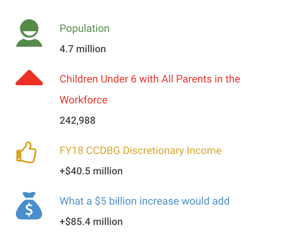
To ensure children are prepared to succeed in kindergarten and beyond, the Louisiana legislature passed the Early Childhood Education Act in 2012. This legislation created a statewide system with unified expectations for knowledge and practice for early care and learning and improved access to quality options for families. As a result, Louisiana is seeing an increase in the quality of early childhood classroom interactions. To further advance these efforts, in 2018 the legislature established the Early Childhood Care and Education Commission to build upon the system’s strengths and develop a plan to address current gaps.
The Louisiana poverty rate is nearly 20 percent, ranking 49th nationally. The Annie E. Casey Foundation’s 2018 Kids Count Data Book also ranks Louisiana 49th for overall child well-being. Two-thirds of Louisiana children under age five have both parents, or their single parent, working. However, due to inadequate funding, the current child care system cannot meet these parents’ needs. Fewer than 7 percent of in-need children aged two and under, and fewer than 33 percent of three-year-olds, can access quality child care in Louisiana. Furthermore, Louisiana’s economy has lost $1.1 billion annually due to employee absences related to unavailability of child care.
This gap in access to quality child care negatively impacts children’s learning and their families’ participation in Louisiana’s workforce. Increased CCDBG funding is needed to enable Louisiana to increase the availability and quality of open child care slots and increase the subsidy rates to ensure working families can afford to access quality care.
Thank you to our partners!
Volunteers of America Greater Baton Rouge
Maine
CCDBG Update: 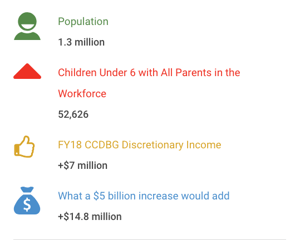
The historic increase of $7 million in FY2018 allowed Maine to increase child care subsidy payment rates to providers to the federally recommended 75th percentile. This means more providers will be able to afford to accept children on subsidy, expanding access for these families. In addition, the funds are supporting the state in meeting the criminal background check requirements for providers.
However, as the state continues to struggle under the opioid epidemic and difficult economic conditions, and with the cost of child care rivaling or exceeding the cost of college tuition in Maine, more CCDBG funding is needed in order to expand access to families. Currently, Maine has a large unmet demand for child care and an underdeveloped early care and education infrastructure. A staggering 73 percent of children in Maine ages 0-5 have all parents in the workforce, and the state is just one of three nationwide that lacks comprehensive child care resource and referral services. This makes it difficult for families to find available resources and select child care programs that best suit their needs.
Moreover, the early care and education field experiences high rates of turnover, with many child care providers closing their doors permanently. A primary cause is that early educators (often referred to as child care workers) are historically paid low wages. In fact, the average wage in Maine is just $11.18 per hour, and many full-time early educators lack benefits and even qualify for public assistance themselves.
Increased CCDBG funding will help Maine develop the infrastructure to better support families, recruit and retain high-quality early educators, and ensure all children have a strong early childhood foundation.
Thank you to our partners!
Maine AEYC
Maryland
CCDBG Update: 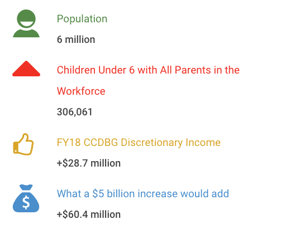
In FY2019, Governor Larry Hogan announced that Maryland’s Child Care Subsidy (CCS) Program would allow more children across the state to access quality child care and educational programs, thanks to the historic increase in CCDBG funding.
Effective August 2018, annual income eligibility limits for the CCS Program were effectively doubled from $35,702 to $71,525 for a family of four. Additionally Governor Hogan approved the funding needed to eliminate the CCS Program waitlist that was established in March 2011. These changes to the CCS Program will result in more Maryland children arriving at elementary school with the foundation needed for success.
In addition, the governor provided much needed funding to increase the CCS Program provider reimbursement to the 20th percentile. He also signed legislation that mandates an increase in these rates over the next three years to not less than the 60th percentile, making Maryland the first state to establish a floor for rates. This is crucial since increased rates enable providers to cover the costs of care for children on the subsidy and ultimately increases access for these children to quality programs. With an increase in CCDBG funding for FY2020, Maryland would plan additional improvements to the CCS Program. This includes raising reimbursements for family child care, which have been historically lower than center-based care, and raising the overall reimbursement rate to the 75th percentile.
With these changes, Maryland experienced a 35 percent increase in families using the subsidy program. It is anticipated that increased CCDBG funding would allow even more utilization of the program by Maryland families.
Thank you to our partners!
Maryland Family Network
Massachusetts
CCDBG Update: 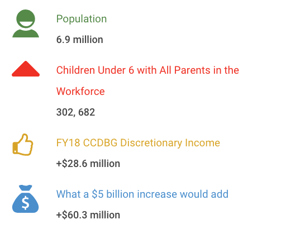
In FY2018, Massachusetts received a historic $28 million increase in discretionary funding. These funds are helping Massachusetts meet more stringent monitoring and oversight requirements, increasing the reimbursement rates for child care providers, and enhancing its technology systems. Massachusetts’ goal is to have a stable, high-quality early education system statewide by ensuring that early education programs are safe, enriching, high-quality and accessible to all families. It's also important that early educators are highly-qualified, professionally-supported, and adequately compensated.
Massachusetts recently launched a StrongStart: Quality Early Education and Care initiative that focuses on early educator workforce development and program improvement to support children’s healthy development and success. StrongStart provides comprehensive resources for educators to attain higher qualifications and programs to attain higher levels of quality.
An increase in CCDBG discretionary funds would help advance Massachusetts’ quality system-building efforts and provide additional infrastructure that supports educators and programs such as new learning management software, interactive training, online licensing platforms, and enhanced background record check systems.
Thank you to our partners!
Massachusetts Child Care Resource & Referral Network
Michigan
CCDBG Update: 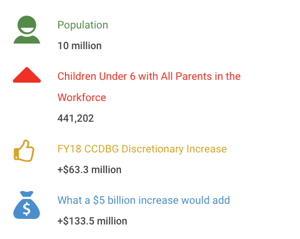
In FY2018, Michigan received a historic $62.8 million increase in CCDBG discretionary funding. This money will be used to update the payment structure for subsidy providers, expand T.E.A.C.H. Scholarships for providers pursuing additional educational credentials, and invest in caseload increases.
While the increase in funding has been important, increased investments are important to expand access to quality child care for Michigan’s working families. Currently, the initial eligibility rate for child care assistance is set at 130 percent of the federal poverty level (FPL), one of the lowest initial eligibility rates in the country. This means that a single parent making a salary of $22,000, or a couple with a household income of $27,000 per year, would not qualify for assistance. But with the annual cost of child care ranging from over $7,300 in a home to over $10,600 in a center, these families would not be able to afford child care. Many Michigan families remain ineligible for child care subsidy in Michigan, hurting their ability to afford child care. A strong, sustained CCDBG investment could allow Michigan to address this.
In addition, Michigan is facing a shortage of child care providers, leading to the formation of “child care deserts” across the state. In fact, many family child care providers are closing their doors every month in Michigan. Part of this is due to low compensation: the average salary of a child care worker in Michigan is currently just $23,020 and early educators often lack access to benefits. Increased funding could go towards better supporting the workforce and retain qualified providers.
Finally, in addition to addressing eligibility and the workforce, increased CCDBG funding will help Michigan meet provisions of the CCDBG reauthorization requirements, including comprehensive background checks for over 90,000 providers, employees, and adult family members in homes and group homes.
Thank you to our partners!
Michigan Dept. Of Education's Office of Child Development and Care
Minnesota
CCDBG Update: 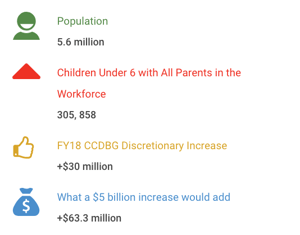
In Minnesota, only 16.3 percent of family child care and 23 percent of center-based provider rates are fully covered by current reimbursement levels. This is primarily because rates have not been increased since 2014, which were based on the 2011 Market Rate Survey. This means the vast majority of providers accepting children on subsidy must cover the remaining cost some other way—often operating at a loss. When providers are unable to cover these costs, it results in fewer child care opportunities for families.
For FY 2020-2021, Governor Walz is proposing to increase reimbursement rates using the current total increase of $59.8 million in federal CCDBG funds. The governor’s proposal raises rates to be greater than 25 percent of the 2018 market rate or the rates in place at the time of the update.
While higher maximum rates may increase families’ access to high-quality care, it will still leave many providers well below the amount they need in order to offer and sustain quality care. With more CCDBG funding, the rates could be increased to a level that would better serve both families and providers in Minnesota. There is also a need to expand access to the state’s subsidy program since there are still nearly 2,000 families on the waitlist. Additional CCDBG funds could be used to help more families access this program.
Thank you to our partners!
Child Care Aware of Minnesota
Mississippi
CCDBG Update: 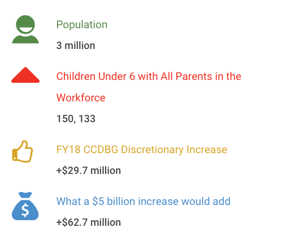
In FY2018, Mississippi received a historic $29.7 million increase in CCDBG funding. However, increased CCDBG funding is still necessary in order to increase access to high-quality child care for children and families in the state.
The average single parent in Mississippi pay 27.8 percent of their income for center-based care for an infant. Married parents of 2 children living at the poverty line pay 40.6 percent of their household income for center-based child care. And the cost of infant care in Mississippi is nearly the same as the annual cost of college tuition at a four-year college. Access to the child care subsidy is critical for working families; without it, many would not be able to access child care at all.
With an average income of just $18,930, which is below the national average, it is difficult to recruit and retain high-quality teachers in Mississippi. This not only harms the child care workforce, but it decreases the supply of high-quality programming for children, leaving Mississippi’s children at risk. More CCDBG funding could help directors recruit and retain quality early educators and provide environments conducive to development and readiness.
Finally, in Mississippi there is a need to support teachers educating children with special needs. Currently educators do not receive support in child care environments for children with an Individualized Education Program (IEP). Increased CCDBG funding could be used for technical assistance in those classrooms to help ensure that children with individualized needs are supported by increasing teachers’ access to formal support in their classroom practices, lesson planning, and social-emotional support and differentiation for children who have individualized special needs.
Thank you to our partners!
Early Childhood Academy
Missouri
CCDBG Update: 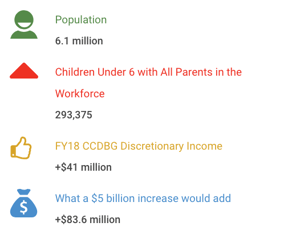
In FY2018, Missouri received a historic $40 million increase in discretionary CCDBG funding. These funds have allowed Missouri to begin implementing comprehensive background checks and other improvements to safety measures, provide increased professional development such as the CDA Scholarship Project, increase supports for those caring for infants and toddlers, provide trauma informed training, and address new provider reimbursement rates because of the completion of a new market rate survey.
Despite these improvements, Missouri still needs more resources to improve access to and safety of quality early childhood programs. Increased CCDBG funds would support the development and implementation of a statewide quality improvement system (QIS) to complement the evolving Missouri Quality Assurance Report (QAR) project and align with efforts outlined in Stronger Together Missouri Preschool Development Grant. With the indicators of quality care being defined and raised through the QAR, it is essential to have an identified and coordinated QIS to make training, technical assistance, and other classroom and business improvements accessible to child care educators. Funding evidence-based professional development in Missouri is the only way to ensure child care educators’ access to the education and development. This leads to an elevation of the quality of care delivered while professionalizing the child care industry and valuing it as a workforce development issue.
With the increased CCDBG investment and the creation of a Missouri QIS, Missouri needs to focus on professional development standards and competencies and a Career Pathways system. Successful in many states, a career pathways system would present a clear and defined view of the many ways into the early childhood profession and the career possibilities offered. Without such a tool, Missouri’s child care educators are limited in their ability to navigate and grow child care and early education from an occupation to a profession.
Thank you to our partners!
Child Care Aware of Missouri
Montana
CCDBG Update: 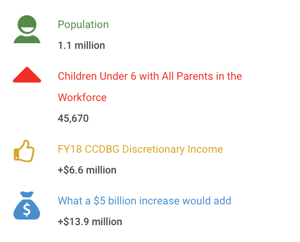
In FY2018, Montana received almost $15 million in discretionary funding, a historic high. These funds have allowed Montana to meet the increased inspection and criminal background check requirements for providers and increase provider payments rates to the 75th percentile of 2016 market rates as of September 2018. In addition, Montana expanded the age range to which the higher payment rates for infants and toddlers apply; the age range was previously birth to 24 months and is now birth to 35 months.
This is just the beginning, however. It is going to take consistent increases in funding to bring the quality and accessibility to families in order to ensure all children have a strong early childhood foundation. For FY 2019-2020, Montana is proposing to use additional funding to promote family engagement, continued emergency preparedness plans, build its workforce, address the “child care deserts” in our most rural areas, and have a continued focus on the requirements of the 2014 reauthorization. With an increase of $5 billion in federal CCDBG funding, Montana would reach 1,489 more children. This additional funding will allow us to serve more families and providers in our great state and build a foundation for children to thrive now and in the future.
Thank you to our partners!
Family Connections MT
Nebraska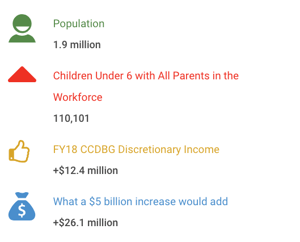
CCDBG Update:
In Nebraska, 76 percent of parents work outside the home and nearly 80 percent of Nebraska’s children ages 5 and younger are in paid child care. The majority of Nebraska’s families are working and relying on child care programs to educate and care for their young children.
]In 2016, over 29,000 children were utilizing Nebraska’s child care subsidy to help cover the cost of child care. With the annual cost of center-based child care for one child well over $12,000, expanding access to the subsidy is crucial for Nebraska families. More CCDBG funding could expand access to high-quality child care programs by increasing the eligibility rate for families to qualify for subsidy.
Robust CCDBG funding could also be used to raise the subsidy rate paid to providers, which Nebraska has recommended to be set at 60 percent. Unfortunately, this is below the recommended rate of 75 percent. Low subsidy rates mean providers must find ways to cover the cost of care, discouraging them from taking more children on the subsidy.
Early childhood professionals play an incredibly important role in providing infants and young children with essential interactions, opportunities, and experiences that help to grow strong brains. An additional increase in CCDBG funding for Nebraska would provide more, and better, professional development opportunities for early childhood educators. This includes an expansion of T.E.A.C.H. Early Childhood® Nebraska scholarships, increased access to quality improvements for early childhood programs serving infants and toddlers (such as Sixpence and the Infant/Toddler Initiative), support for Nebraska’s Step Up to Quality (Nebraska’s Quality initiative), and increased compensation for the workforce.
Thank you to our partners!
Nebraska AEYC
Nevada
CCDBG Update: 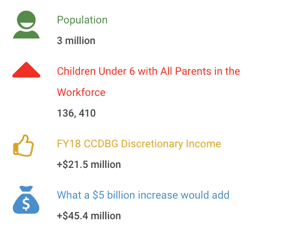
In FY2018, Nevada received a historic $21.5 million increase in CCDBG funding. This funding enabled Nevada to increase the number of eligible children served by the subsidy. Additionally, the funding enabled Nevada to increase the number of providers participating in its quality rating system by investing in support mechanisms such as coaching.
The historic increase also enabled Nevada to raise the subsidy reimbursement rate from the 2004 market rate to the 2015 market rate. Subsidy reimbursement is crucial for helping providers cover costs for children using the subsidy, and low rates make it difficult for providers to accept more children on the subsidy. In Nevada’s case, relying on outdated market rates was straining the system. Increasing these rates was a major step forward.
While the increase in CCDBG funding has been great for Nevada, continuing to increase funding could help address persisting issues. For example, even though Nevada raised subsidy reimbursement to the 2015 market rate, CCDBG requires the use of current market rates. If Nevada does not make more changes, the gap will increase again and problems will reemerge. Moreover, Nevada’s subsidy program only serves 5.84 percent of eligible children. While this is up from 3.21 percent in 2015, it remains far below the national average, and the majority of eligible children remain unserved.
Additionally, increased CCDBG funding could help Nevada invest in the workforce. Currently, the average starting wage for a child care teacher is $10.90 per hour, and only 18 percent of licensed providers are receiving health insurance benefits. In fact, many child care teachers even qualify for the child care subsidy themselves.
Finally, Nevada’s state preschool program is funded below 2001 levels and ranked 42nd in state spending per child. In 2014, Nevada received a 4-year federal grant to expand the number of children participating in high-quality preschool programs. Along with legislative action, the program requires an increase in preschool funding by more than $14 million annually.
Thank you to our partners!
The Children's Cabinet
New Hampshire
CCDBG Update: 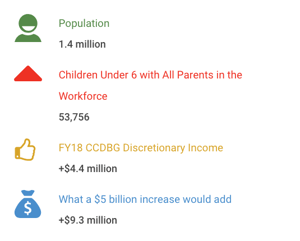
In FY2018, New Hampshire received a historic increase of $4.4 million. While this funding has helped improve the child care system in New Hampshire, there is still more that needs to be done. Currently, there is a deficit of more than 22,000 licensed child care spaces across the state of New Hampshire. With more than 53,000 children under the age of 6 in working families across the state, this means that 2 in 5 children in working families do not have access to licensed child care while their parents are at work. This is particularly the case for infant/toddler care. Additional funding would assist the state to increase its capacity to serve our youngest children.
In addition to access, increased funding could help improve the quality of care in New Hampshire, particularly by expanding incentives to assist child care programs in improving the quality of their care. Since New Hampshire’s Quality Rating and Improvement System (QRIS) is voluntary, increasing quality incentives is necessary to encourage broader participation. The additional funding would also allow for more tuition assistance for child care professionals seeking to further their education, which would result in better staff qualifications. School-age programs could also receive more support in the form of higher Child Care Scholarship Program payments to support the field of afterschool professionals.
Thank you to our partners!
Child Care Aware of New Hampshire, Southern New Hampshire Services
New Jersey
CCDBG Update: 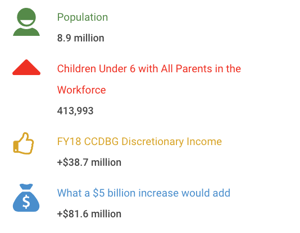
In FY2018 and FY2019, New Jersey received historic increases of about $38.7 million annually in Child Care and Development Block Grant (CCDBG) discretionary funding. These funds have helped New Jersey to increase subsidy rates, provide support to providers to comply with CCDBG health and safety requirements, and offer incentives to expand the supply and increase the quality of child care available for infants and toddlers. Nevertheless, funding has been insufficient to raise child care subsidy rates in a manner high enough to reflect market rate prices and fully support the costs of operating high-quality programs.
About 939,270 children under age 13 in New Jersey have working parents, of which about 402,270 of these children are under the age of 6. About 44,400 children received a child care subsidy in FY2017, which is a tiny fraction of eligible children. Today, the cost of child care a struggle for many families. Therefore, it’s critical that CCDBG funding be increased so that the gap between those families who are eligible for child care assistance and those families who are fortunate enough to receive it is closed. A $5 billion increase would likely more than double the number of children in low income families served and also offer an opportunity for New Jersey to further increase subsidy rates to better support the higher costs associated with operating a high-quality program.
Thank you to our partners!
Child Care Aware of New Jersey
New Mexico
CCDBG Update: 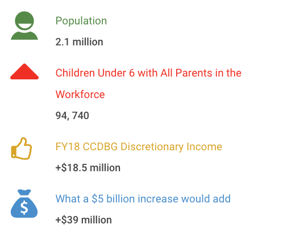
Earlier this year, New Mexico Governor Michelle Lujan Grisham signed Senate Bill 22, which will bring all early childhood programs under its own agency, the Early Childhood Education and Care Department, within the next year. This means strong coordination with clear and focused leadership between all programs that govern services for children ages 0 to 5.
While this new agency will be imperative in coordinating services, New Mexico will be utilizing the federal Preschool Development Grant to conduct a comprehensive needs analysis utilizing data from the Early Childhood Integrated Data System (ECIDS) as well as qualitative data gathered through public forums across the state. Increased CCDBG funding could help New Mexico expand this needs analysis in order to better understand the state’s child care and early education landscape. This assessment will drive the creation of a 3-year roadmap to continue the development of a high-quality early learning system, including continuing to work towards recruiting and retaining quality providers. All of our efforts in New Mexico are family-centered, with an emphasis on access, equity, respect, and informed choice for all of our diverse community needs.
Thank you to our partners!
New Mexico Children, Youth, and Families Department
New York
CCDBG Update: 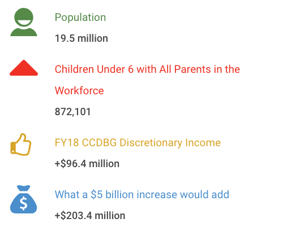
In FY2018, New York received a historic $95.7 million increase in discretionary funding. These funds will allow New York to meet the increased inspection and criminal background check requirements for providers, to provide increased professional development, and to increase the focus around quality care for infants and toddlers. Through the increased infant/toddler set aside requirement, our network has been able to approximately double the number of Infant/Toddler Specialists that are working with programs on quality around the state.
However, New York still needs in excess of $550 million to fully implement all requirements. This includes requirements around child care subsidies, such as 12-month eligibility and graduated phase out, as well as payment for absences.
Additionally, the availability of licensed and regulated child care options for families with children 2 years old and under is limited across all income levels. This is particularly acute for families with low to moderate incomes, many of whom are just above the threshold of 200 percent of poverty. In much of the state, providers who care for infants and toddlers are at 90 percent of their capacity. In some urban areas, nearly all existing care is being utilized, and there are long waitlists. In many rural areas, regulated child care options for children of all ages still do not exist. Increased CCDBG funding would help address this gap.
Thank you to our partners!
Early Care & Learning Council
North Carolina
CCDBG Update: 
In FY2018, North Carolina received a historic $74.3 million increase in CCDBG funding. State policymakers used these additional funds to expand services to eligible families on the child care waitlist. They also increased child care subsidy reimbursement rates for young children in three-, four- and five-star child care programs to the 100th percentile of the 2015 market rate in Tier 1 and 2 counties and the 75th percentile in Tier 3 counties. And based on preliminary budgets by the North Carolina House and Senate, advocates expect there to be more funding for subsidies this legislative session.
Subsidy reimbursement rates are crucial for helping providers cover the costs of caring for children using the subsidy. Increasing the rate encourages providers to accept more children on the subsidy, thus expanding access to quality programs for families with low incomes.
Despite the large step forward, there are still nearly 30,000 eligible families on the child care subsidy waitlist in North Carolina, and only 18 percent of all families that qualify for child care services actually receive them due to a lack of funding. North Carolina would need an additional $31.5 million to serve approximately 6,000 more children for FY2020.
Thank you to our partners!
North Carolina Early Education Coalition
North Dakota
CCDBG Update: 
In FY2018, North Dakota received a historic $3.7 million increase in CCDBG funding. This funding has allowed the state to increase access to child care assistance from 70 to 75 percent of state median income.
Unfortunately, there remains a large unmet demand for child care in North Dakota. A staggering 70.4 percent of children in North Dakota ages 0-5 have all parents in the labor force. However, the current supply of state-licensed child care programs only meets 36 percent of potential demand, resulting in a large gap for access. These “child care deserts” make it difficult for working parents to support their families, especially in rural areas. Increasing CCDBG funding will help North Dakota address these deserts.
In addition, North Dakota’s child care infrastructure remains underdeveloped. For example, North Dakota still lacks a licensing database and a system of tiered reimbursement for child care providers. This makes it difficult for families to select child care programs that best suit their needs. More CCDBG funding could help North Dakota develop the infrastructure to better support families and providers.
Finally, North Dakota continues to require a waiver on implementing background checks. The 2014 reauthorization of CCDBG requires full implementation of background checks by 2021. Without an increase in funding, it is unlikely North Dakota will be able to fully implement the background check requirement.
Thank you to our partners!
Child Care Aware of North Dakota
Ohio
CCDBG Update: 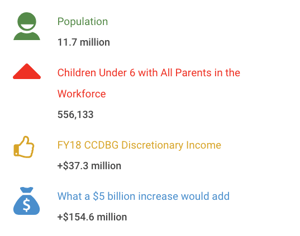
In Ohio, only about 40 percent of family child care and center-based programs are participating in the state’s Quality Rating and Improvement System (QRIS), Step Up To Quality (SUTQ). This equates to 60 percent of the nonrated programs being reimbursed at less than the 20th percentile of the 2016 Market Rate Survey. Many of the programs serving Ohio’s most economically disadvantaged children have parents pay for subsidizing the state-funded children to break even or may be operating at a loss each year. When providers are unable to cover these costs, there are fewer child care opportunities for families.
For FY 2020-2021, Governor DeWine is proposing to increase reimbursement rates using the current annual increase of $73 million in federal CCDBG funds. The governor's proposal raises the base rates to greater than 25 percent of the 2018 market rate or the rates in place at the time of the update.
While higher rates may increase families’ access to high-quality care, it will still leave many providers well below the amount they need in order to offer and sustain quality care. With more CCDBG funding, the rates could be increased to a level that would better serve both families and programs in Ohio. Governor DeWine wants to raise eligibility for publicly funded child care subsidies from 130 percent of the federal poverty level to 150 percent federal poverty level. There is also a need to expand access to the state’s subsidy program. In order to serve an additional 22,000 children, an additional $73 million in CCDBG funding is necessary. Additional CCDBG funding could be used to help more families access this program.
Thank you to our partners!
Ohio Child Care Resource and Referral Association
Oklahoma
CCDBG Update: 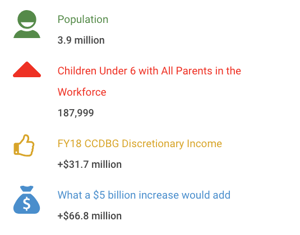
As the first state to have a tiered provider reimbursement system tied to quality, Oklahoma has been a leader in creating a strong child care system. However, since the 2014 reauthorization of CCDBG, many states have now surpassed Oklahoma. In addition, child care programs had not received an increase in payment for nearly a decade.
Oklahoma received an additional $32 million in FY2018 and immediately put the dollars to work. For example, the subsidy reimbursement rate for providers was raised from the 39th to the 70th percentile. For a 2-star program with 20 children utilizing child care assistance, this is about $5,000/month to raise teacher wages, invest in professional development, or purchase materials for the classroom.
In addition, $8 million was used to raise the eligibility income for families. At a time when families are not at their highest earning potential, they are forced to pay more than the cost of tuition for quality child care. A family of four making $56,000 is now eligible for child care assistance and no family will have a copay more than 7 percent of their household income.
While the increase in funding has helped Oklahoma, more must be done. Only 8 percent of children who need care utilize the child care subsidy. Provider rates are still not at the recommended 75th percentile of the market. In addition, there has been a 35 percent decline in the number of licensed child care programs over the last decade. Maintaining access to quality, affordable child care has the potential to serve as a viable economic development policy channel going forward. With more CCDBG funding, we can do it.
Thank you to our partners!
Oklahoma Child Care Resource & Referral Association
Oregon
CCDBG Update:
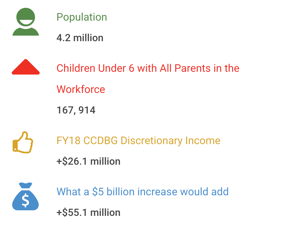
Oregon is in a child care crisis that can only be addressed through additional investments. According to a study by the Center for American Progress, Oregon is a child care desert, or a location where there are more than three children per licensed, available child care opening. Infant-toddler care in Oregon is even more scarce, with 6.8 children per opening. Additionally, Oregon’s child care assistance program has among the highest parent co-pays in the nation, leaving families with low incomes spending as much as 30 percent of their income on child care and only serves 16 percent of eligible families.
Economic competitiveness and gender equality are undermined when families experience a lack of affordable, reliable, and quality child care. Economic competitiveness is weakened when employers experience reduced attendance, productivity and retention due to employees’ child care challenges. And because mothers have traditionally borne a greater burden of child care responsibilities, lack of access causes women to be disproportionately forced out of the workforce.
With additional discretionary funds Oregon could:
- • Reduce parent co-payments to no more than 7 percent of a family’s income.
• Increase child care subsidy rates to centers, creating access to more choices for families with low incomes.
• Be used to invest in Baby Promise to create safe, high-quality child care openings for infants and toddlers.
• Reduce the ratio of child care licensing specialists to facility. Currently, Oregon employs one specialist for every 138 providers, even though experts recommend one for every 50 child care facilities.
Pennsylvania
CCDBG Update: 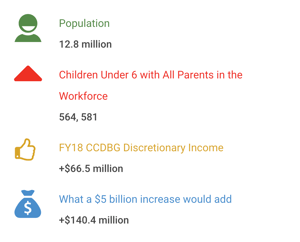
In FY 2018, Pennsylvania received a historic $66.5 million increase in discretionary funding, resulting in a subsidy rate increase across all care levels by 2.5 percent and elimination of a rate freeze. A pilot program was created to contract for subsidized, high-quality slots specifically for infants and toddlers. Funding was also allocated to support professional development for child care providers and to implement CCDBG background check requirements. Governor Wolf also proposed using remaining funds to serve 970 infants and toddlers on the waiting list in high-quality programs, increase quality add-on rates for infant and toddler care, and support apprenticeships for infant and toddler providers to achieve associate degrees.
However, there is still a great unmet need in Pennsylvania. Too many children do not have access to affordable, high-quality care. Only 37 percent of subsidized children under age five and 34 percent of subsidized infants and toddlers are in high-quality programs. Only 43 percent of available child care in the state currently meets high-quality standards. The subsidy waitlist is at 5,795 children, with an average wait of about 110 days as of May 2019. In addition, 73 percent of eligible children under age five and 77 percent of eligible infants and toddlers are not enrolled in the subsidy program.
Pennsylvania’s payment rates fall far short of supporting high-quality care and further investments are needed to appropriately compensate the workforce and support providers in earning higher degrees and credentials. Increased CCDBG funding would help address these gaps so that all Pennsylvania children can get a strong start.
(Unmet need data is provided by KIDS COUNT: Pennsylvania Partnerships for Children, with the exception of the waiting list data, which is provided by the Pennsylvania Office of Child Development and Early Learning.)
Thank you to our partners!
Pennsylvania AEYC
Rhode Island
CCDBG Update: 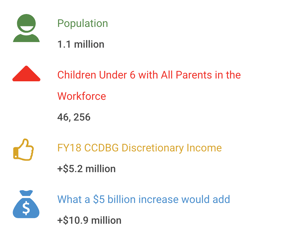
The recent funding increase of $6.6 million for FY2018 and FY2019 for the Child Care and Development Block Grant (CCDBG) has allowed Rhode Island to continue to promote high-quality health, safety, and education in early childhood education (ECE) programs across the state. The state used most of the increased federal funds to create and support a tiered reimbursement payment system. In order to continue to meet the unique spectrum of needs that the 55,000 children under age 5 in Rhode Island deserve, we must ensure continued funding for high-quality early learning experiences and a qualified workforce.
April 2018 research by the Rhode Island Department of Human Services (DHS) identified that additional technical assistance and coaching is necessary to better meet the needs of ECE programs in attaining high-quality care. Moreover, additional funding is needed to expand offerings to these programs during a critical time of improvement. Only 13 percent of the roughly 800 programs participating in the BrightStars Quality Rating and Improvement System meet the highest tiers of quality at 4 or 5 Stars.
According to the National Women’s Law Center (NWLC), current provider payment rates in Rhode Island fall below the federally recommended level of the 75th percentile of current market rates (designed to give families access to 75 percent of the providers in their community) at approximately 50 percent as of February 2018. While the recent funding increase is helping RI make progress in improving families’ access to child care assistance, further federal and state investments will be necessary to fully address these and other gaps.
All families in Rhode Island deserve the security of accessible, high-quality care.
Thank you to our partners!
Rhode Island AEYC
South Carolina
CCDBG Update: 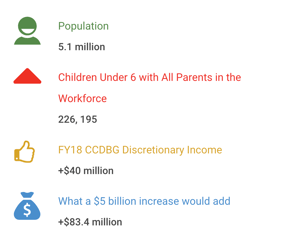
In FY2018, South Carolina received a historic $40 million increase in CCDBG funding. These funds will help expand access to child care for working families. However, there are over 225,000 children under the age of 6 with all parents in the labor force. The $40 million increase works out to less than $180 per child in potential need of child care. With the annual cost of care of center-based care over $6,800, it is clear that a more robust CCDBG investment is necessary to expand access to quality child care.
For many South Carolina families, the subsidy is the only way to afford child care. For example, without the subsidy, the average single parent would need to pay 31.7 percent of their income for center-based care for an infant. In addition, married parents of 2 children living at the poverty line would need 51.6 percent of their household income for center-based child care. Without expanding the subsidy, child care remains out of reach for most South Carolina families.
The current income limit for subsidy reimbursement is just 150 percent of the federal poverty level. This means that a single parent making over $25,000, or a couple making over $32,000, would not qualify for assistance. With the cost of infant care in South Carolina almost half the cost of college tuition at a four-year college, many of these families could not afford the cost of child care and consequently remain locked out of the system.
Finally, increasing CCDBG funding is necessary in order to expand the supply of child care. Increasing supply starts with the recruiting and retention of quality child care providers and early educators. Unfortunately, the annual income of child care workers in South Carolina is just $20,370—well below the national average. In fact, many child care providers qualify for the subsidy themselves and often lack access to benefits. Utilizing CCDBG funding to provide resources for wage increases in the child care field would result in an increase of supply.
Thank you to our partners!
South Carolina AEYC
South Dakota
CCDBG Update: 
South Dakota received an increase of $5.6 million in CCDBG discretionary funding in FY2018. This enabled South Dakota to update its subsidy payment rates (at the 75th percentile) to providers from 2015 market rates to 2017 market rates. Updating these rates is crucial, since they influence whether providers can afford to accept more families on subsidy, which in turn expands access for South Dakotans.
Despite this, South Dakota still needs more CCDBG funding to expand access for children and families. Currently, the income eligibility to qualify for child care assistance in South Dakota is at 179 percent. This means that a single parent making a $30,000 salary, or a couple with a household income of $38,000, would not qualify for assistance. But with the cost of child care averaging $5,000 to $6,000 per year, these households could still not afford the cost of care and remain locked out of the system. Strong CCDBG investment could help families who are locked out of the subsidy system gain access to care.
CCDBG funding could also help support the workforce in South Dakota. Currently, the average income for a child care worker is just $21,200. Not only is this below the national average, but this means many child care workers often qualify for public assistance themselves. This, in turn, leads to high turnover in South Dakota and creates child care deserts throughout the state. Increased funding could allow South Dakota to invest in the workforce and retain qualified educators.
Thank you to our partners!
South Dakota AEYC
Tennessee
CCDBG Update: 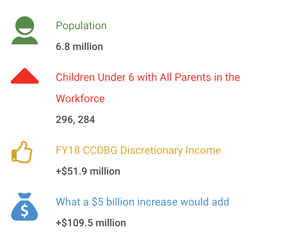
In FY2018, Tennessee received a historic $52 million increase in discretionary CCDBG funding. This funding enabled Tennessee to increase weekly reimbursement rates for child care providers participating in the state’s Child Care Certificate Program for the first time since 2008. The rates will increase 35 percent for infant and toddler care and 20 percent for preschool and school-age care. Increasing rates will help expand access to quality child care in the state and catch up on meeting CCDBG requirements for providers such as background checks.
Despite this step forward, a lot of work remains to be done in Tennessee. As of 2018, there were 296,284 children under the age of 6 with all parents in the workforce. This means the historic increase works out to just $175 per child in potential need of care. With the cost of infant care exceeding $8,500 in a center and $6,000 in a home, more CCDBG funding is necessary in order to expand child care access for working families in Tennessee. Without subsidy, many of these families cannot afford the cost of care.
Finally, there is a need to increase the supply of child care in Tennessee, particularly in rural areas. Currently, the child care field experiences high rates of turnover, with many providers closing their doors permanently. A primary cause is that child care workers are historically paid low wages, with the average annual income of a child care worker in Tennessee making just $20,670, which is below the national average. In fact, many full-time child care workers lack benefits and even qualify for the subsidy themselves. Increasing CCDBG funding can help address this wage crisis and allow Tennessee to recruit and retain qualified early educators and child care providers.
Thank you to our partners!
West Tennessee Healthcare and Education
Texas
CCDBG Update: 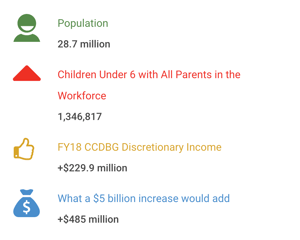
In FY2018, Texas received a historic $230 million increase in CCDBG funds. With this increase, Texas will serve an estimated 28,000 children who were on the waiting list for child care assistance. The state also increased its base payment rates for providers by 2 percent and added higher percentage increases for each star level of the state's quality and rating system (QRIS), with the rate for providers at the four-star level of QRIS increased to the recommended 75th percentile. The state was able to use additional funding to expand public-private partnership initiatives between public Pre-K and QRIS child care programs, provide support to providers affected by Hurricane Harvey, expand infant and toddler programs, provide Shared Services business supports, invest in QRIS mentors and assessors, make data system enhancements, and invest in professional development resources.
While these are steps forward, a lot of work remains to be done in Texas. As of 2019, there are still 16,000 families on the waitlist for child care assistance. Moreover, Texas is currently only serving an estimated 10% of all eligible children. With the cost of infant care at over $9,000 in a center and nearly $7,000 for a home, more CCDBG funding is necessary in order to expand child care access for these working families in Texas. Without expanding access, many of these families cannot afford the high cost of care.
Finally, there is a need to increase the supply of quality child care in Texas, particularly in rural areas. However, qualified child care workers are historically paid low wages. The average annual income of a child care worker in Texas making just $21,570, which below the national average. In fact, many full-time child care workers lack benefits and even qualify for the subsidy themselves. Coupled with a lack of career opportunities, this causes a high rate of turnover in the field, with many providers closing their doors permanently. Increasing CCDBG funding can help address this wage crisis and create new professional development pathways such as an apprenticeship model, which would allow Texas to recruit and retain qualified early educators and child care providers.
Thank you to our partners!
Texas Association of Child Care Resource and Referral Agencies, Children At Risk
Utah
CCDBG Update: 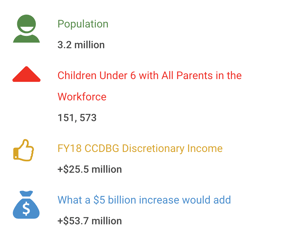
In FY2018, Utah received a historic $25.4 million increase in CCDBG funding. This funding has been crucial in helping Utah implement CCDBG reauthorization requirements and implement its new quality rating and improvement system, Child Care Quality System (CCQS).
Despite these improvements, Utah still needs more funding to expand access to working families. Currently, Utah does not have a waitlist for child care subsidy payments. This is due to conservative qualification guidelines that may result in preventing families from access. Yet with the average cost of infant care in Utah at $7,344 in a home and $9,708 in a center, families still cannot afford child care. In fact, on average a single parent would need to spend 33.9% of his/her income to afford center-based care.
Utah has worked hard to eliminate barriers to allow families easier access to programs, including removal of the copayment for families living at or below the poverty rate. These measures, along with higher market rates, are crucial for enabling providers to accept families on the subsidy.
Increasing CCDBG funding would help expand child care access for Utah families. Utah will use additional funds to broaden its eligibility criteria for receiving subsidy. It could also increase income thresholds to be eligible for child care and include a broader range of education and training activities as eligible activities that would expand access to child care subsidies.
Thank you to our partners!
Children's Service Society of Utah
Vermont
CCDBG Update: 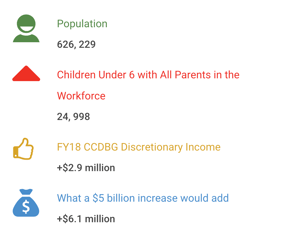
In FY2018, Vermont received a historic $2.8 million increase in CCDBG discretionary funds. This funding enabled Vermont to increase payment rates for infant and toddler care and invest in its tiered payment rates for higher quality care. With initiatives like this, 67 percent of children on subsidy are now in 3, 4 or 5-star quality programs. The funding was also used to hire three new child care licensors in the Department of Children and Families.
Vermont’s focus is on equal access for families to regulated child care programs, especially high quality programs. These programs are often more expensive and low income working families struggle to afford child care and the co-payments even when they do qualify for subsidy. Even with the FY18 investments in infant/toddler rates, Vermont’s current full time subsidy rate for a center at one star is at the 15.42 percentile of the 2017 Market Rate Survey. In July 2019, the rate will rise due to state investments, but only to the 18.92 percentile of the 2017 Market Rate. In 2019 the state will be conducting another Market Rate Survey and it is anticipated that all market rates will have increased. This impacts the access and affordability for low income working families. Any additional CCDBG funds would be dedicated to increasing the subsidy rates to increase access for low-income working families.
Thank you to our partners!
Vermont Department for Children and Families
Virginia
CCDBG Update: 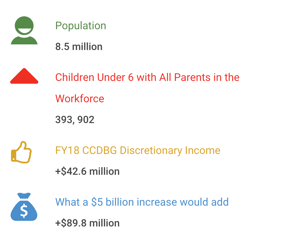
In FY2018 and 2019, Virginia received historic increases of about $42.5 million annually in CCDBG discretionary funding. These funds have helped Virginia to increase subsidy rates, provide support to providers to comply with CCDBG health and safety requirements, and cover the cost of background checks to ensure those with a violent criminal history or individuals who are on the child abuse registry are not working in child care settings. The increase in funding has also led to increased support for quality-related activities to ensure that families have access to high-quality care.
Despite the increased funding, the number of children in Virginia receiving subsidies over the last few years has declined. Some of that decline is related to a shift in state policy from using taxpayer dollars to support children in unlicensed care, where the safety of children is unknown, to this year, where the larger majority of children with subsides are in some type of regulated care. The safety of children matters as well as accountability for the use of public dollars.
About 889,285 children under age 13 in Virginia have working parents (395,285 are under age 6). About 18,366 children received child care subsidies in FY18. It’s difficult to determine the exact number of children who are eligible since it is set by the state at 150 percent, 160 percent, 185 percent, and 250 percent of the federal poverty line, based on the locality in which a family resides. However, a $5 billion increase in CCDBG funding would likely more than double the number of children in low income families being served.
Thank you to our partners!
Child Care Aware of Virginia
Washington
CCDBG Update: 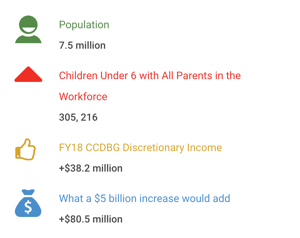
Washington is facing a full-blown child care crisis. Care now costs more than tuition at our state’s universities. Child care educators rank in the 3rd percentile of all occupational wages, making less than pet groomers and parking lot attendants. This directly results in a 43 percent turnover rate amongst teachers. Less than half of all young children in the state who need care are able to access licensed, safe child care. Also, less than half of Washington's kindergarteners enter school prepared for success.
Increased CCDBG funding would address all of these issues! Low subsidy rates undermine the overall system and and currently parents in Washington using subsidy only have access to a fraction of the market. And because communities and programs that are reliant on subsidy are more likely to have people of color and people whose primary language is not English, this becomes a big driver of the opportunity gap. We thank Congress for the last increase to CCDBG, which had a stabilizing impact for many communities. Additional investment will expand access for vulnerable families, increase quality for children, and help stabilize the workforce!
Thank you to our partners!
Child Care Aware of Washington
West Virginia
CCDBG Update: 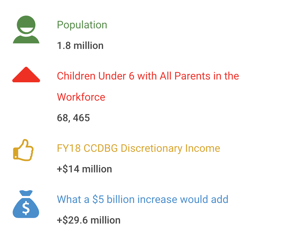
West Virginia has a population of 1.8 million people, nearly one-fifth of whom are living in poverty. The state continues to struggle under difficult economic conditions and the opioid epidemic. Child removals and foster placements are at an all-time high and resources for healthy recovery and family reunification are in short supply.
There is also limited state funding available to refer to supportive family services such as child care assistance. West Virginia’s child care program does not maintain a waitlist and serves all families who are eligible based on incoming and activity. However, due to limited funds, West Virginia cannot currently serve all populations who could benefit from child care assistance. Additional CCDBG funding could assist the state in providing child care to parents who do not meet current eligibility requirements.
Subsidy reimbursement rates for providers directly impact access for families with low incomes. In West Virginia, child care reimbursement rates range from the 50th to the 75th percentile of the March 2018 Market Rate Survey. Rates were last raised to the 75th percentile in March 2016. Additional CCDBG funding would permit West Virginia to increase rates back to the 75th percentile to ensure that children have equal access to care.
Thank you to our partners!
Choices CCR&R - River Valley Child Development Services
Wisconsin
CCDBG Update: 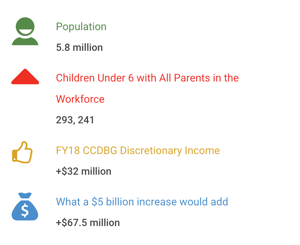
In FY2018, Wisconsin received a historic $32 million increase in CCDBG funds. With this increase, Wisconsin was able to increase payment rates for children birth to three by 5 percent, and increase rates for infant care in all counties to at least $5 per hour. Coupled with TANF funding, the state was also able to increase maximum rates for all age groups by 5 percent, with 4- and 5-star providers receiving 11 percent and 27 percent increases, respectively. Raising these rates is crucial since it helps providers cover the costs for families utilizing the subsidy.
However, with over 293,000 children under that age of 6 with all parents in the workforce, the historic increase works out to just $109 per child in potential need of care. More CCDBG funding could expand access for families who are unable to access child care assistance. Currently, the threshold for qualifying for subsidy is 185 percent of federal poverty level. This means that single parents making $32,000 per year, or couples making $40,000 per year, do not qualify. But with the cost of infant care exceeding $12,000 in a center and $9,000 in a home, many families cannot afford quality care and remain locked out of the system. Increasing CCDBG funding could increase eligibility rates, giving more working families access to care.
Finally, child care providers in Wisconsin need assistance to meet the new CCDBG requirements, including background checks. An increase in CCDBG funding would help provide the technical support and resources necessary to ensure that all providers are in compliance with the updated law.
Thank you to our partners!
Supporting Families Together Association
Wyoming
CCDBG Update: 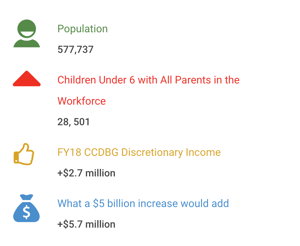
Wyoming has finally arrived at a watershed moment when it comes to the earliest years of life. The historic investment in the state’s early care and education system in FY2018 coincided with historic conversations to collaboratively move the needle for young children and families.
This narrative is just beginning, though, and additional dollars will be needed to propel collaboration beyond efficient use of existing dollars. Improvements to the system have not closed the gap on the number of children who do not have access to high-quality child care and education – especially in the state’s most rural spaces. Even if quality care and education was available for families to choose it, they would struggle to afford it. Child care costs in Wyoming exceed that of attendance at the state’s only four-year university. Additionally, low reimbursement rates for child care assistance burden working families whose incomes are already strained to cover their costs of living.
Unprecedented investment of public and private funds in a statewide professional learning collaborative showcases the rising importance of recognizing and valuing the early childhood workforce. Yet Wyoming perpetuates the economic penalty for working with their youngest children: kindergarten teachers earn an annual mean wage of $56,860 while child care workers earn $23,360. Furthermore, the costs and administrative challenges of starting up and sustaining a business or nonprofit child care are high. Furthermore, new regulations for background checks and fingerprints were implemented without the necessary capacity to make such regulations a seamless part of doing business.
Consistent collaboration and increases in funding allow Wyoming to strengthen its early childhood workforce, to serve families better, and to ensure that all young children have the foundation they need to be successful in their first year of school and beyond.
Thank you to our partners!
Wyoming Kids First


